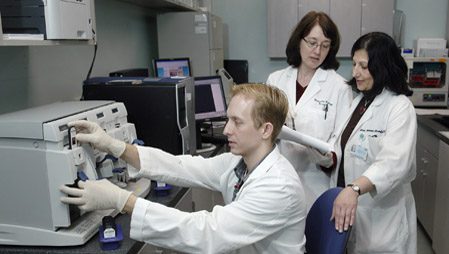High-Throughput Studies
High-throughput Studies can be considered from two perspectives: there are platforms that measure many datapoints per sample; there are also platforms that measure the response of many samples to one treatment.
A transcriptome microarray is one type of high-throughput device, where the complete set of mRNAs present in a sample is assayed for presence and quantity; because the mRNA codes for the functional protein molecules in the cell this has been called functional genomics. The microarray uses DNA probes to capture unique fragments of each mRNA. Hundreds of thousands of such probes must be designed and placed on the array; subsequent to the mRNA binding the signal is captured and quantified. A large part of such experiments lies in the bioinformatics processing and analysis: after signal extraction, values are combined, followed by statistical and machine learning methods so the bioinformatics challenges are considerable, and are not yet solved.
A number of investigators at the BRC use microarray assays to study gene expression in various organisms including humans, Brucella spp., and C elegans.
Another type of functional assay platform uses high-throughput screening (HTS) to measure the response of many samples to a single treatment; generally the sample and reagent handling is done by robots in order to minimize material use and human errors. An important part of the assay is to provide a reporter that indicates whether a desired reaction has occurred. Although the design varies considerably with the organism tested, most such assays use a 96-well plate format, in which the plate contains a growth medium for cells, and which allow for capture of colorimetric, fluorescent, luminescent or chemiluminescent responses for the reporters.
Tools developed by our Faculty: GAGE – Generally Applicable Gene-set Enrichment and Pathway Analysis Pathview – pathway based data integration and visualization

Faculty in this Research Area:
Dr. Cory Brouwer, Director Bioinformatics Services Division and Associate Professor
Dr. Anthony Fodor, Assistant Professor
Dr. Cynthia Gibas, Associate Professor
Dr. Ann Loraine, Associate Professor
Dr. Weijun Luo, Associate Professor
Dr. Jessica Schlueter, Assistant Professor
Dr. Mindy Shi, Visiting Assistant Professor
Dr. ZhengChang Su, Assistant Professor
Dr. Jennifer Weller, Associate Professor